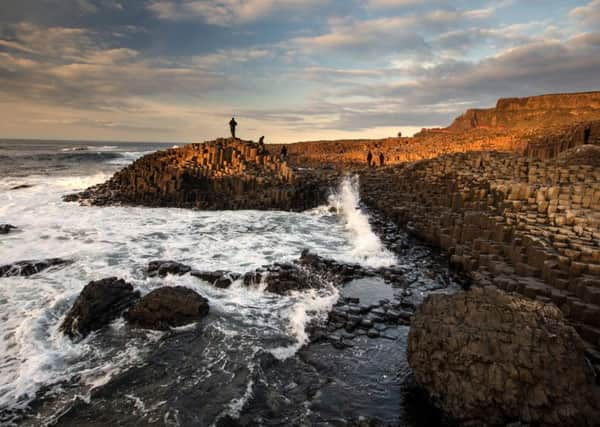More observations of the north coast by visiting London cleric two centuries ago


His 19th century, endearingly-outmoded, clerical narrative is curiously enlightening!
Born in London in 1794, Hamilton was a respected clergyman, theologian, widely-published author and chairman of the Congregational Union of England and Wales.
Advertisement
Hide AdAdvertisement
Hide AdDuring his tour of Ireland in 1828, in association with the Irish branch of the London Missionary Society, he visited the Causeway Coast and mused on “the cisterns or forges in the mighty laboratory of nature” that formed the Giant’s Causeway, created by “the Infinite Architect”.
His trip to Ireland began on April 7, 1828.
He’d been here previously, to “this lovely isle and this noble people” and “cheerfully complied” to return when invited by the Hibernian Auxiliary Missionary Society.
“The little I saw of the scenery which this isle can boast, on a former visit, excited my admiration, and who does not know the mirth, the frankness, the generosity of its native inhabitants.”
He welcomed “revisiting Ireland’s shores…especially as I have better prospect of studying the national character. All nature is attractive to me, but most of all, human nature”.
Advertisement
Hide AdAdvertisement
Hide AdAside from his descriptions of the Causeway and Dunluce Castle, some of his observations about local folk make interesting reading.
His voyage from Liverpool was unpleasant as the ship “reeled about very frightfully, it being what the Captain called ‘a nasty tumbling sea’”.
Hamilton arrived in Dublin, blown about by “an Irish breeze” and embarked on a packed itinerary of church services, hosted by leading clergymen and church members.
On Monday April 21, he “set off for Newry, in the north of Ireland”.
Advertisement
Hide AdAdvertisement
Hide AdDuring his previous trip Hamilton remained in the southern counties so “all this country was new to me. Our route lay through a generally pretty though sometimes barren country”.
He regarded Newry as “a substantial and tolerably clean town”.
On Tuesday, April 22 he “reached Armagh, the see of the Primacy. I made a call upon Dr Ryan, who, and his wife, seem very amiable people. Here too, the Presbyterian minister showed kind attention. The cathedral is most beggarly; it is interesting merely from Usher, who was Archbishop”!
Then to a badly attended meeting at Market Hill on Thursday, April 24 which he described as “unpropitious” and noted “the muster of the county militia staff…the rain fell in torrents and the thunder rolled in peals”.
Advertisement
Hide AdAdvertisement
Hide AdNext day came an ecumenical encounter in Portadown “a neat and rather busy town. I fell in with a Father Quin, a Catholic Priest, rather curiously, while taking shelter from the rain.”
Not unpredictably, Dr Hamilton wasn’t impressed with Father Quin’s theology and concluded that he was “a queer old blade”!
Lurgan was next on his itinerary.
“In the parsonage I found great hospitality. I also rode out to get a sight of Lough Neagh – a majestic reach of water thirty miles long and twelve broad.”
Along with sightseeing, he had a busy preaching schedule.
“I preached morning and afternoon. The congregations where good and attentive,” Hamilton recounted, adding, initially somewhat alarmingly: “The Presbyterian congregation was driven out of their house by the painters, so we had to use the Methodist chapel”.
Advertisement
Hide AdAdvertisement
Hide AdOn the morning of April 29 “we were on our way to Moy, in Tyrone, and found a very welcome reception. I preached and my colleague narrated our travels. The congregation was serious, but small”.
Then to Dungannon where “we had a respectable meeting at the Rev Bennet’s chapel.
Here are very good people – but most of the Establishment”.
Hamilton took time off in Dungannon and “wandered about the town” which he found to be “neat, compact and nobly placed”.
Advertisement
Hide AdAdvertisement
Hide AdCookstown on May 2 was “the most beautiful line of road I had travelled in Ireland and it is the most beautiful town I have seen in these parts. It is a quiet habitation and an interesting people”.
As recounted on Wednesday’s page, it was in nearby Ballygonny that Dr Hamilton took “a day of rest…wandered, chatted, lounged, eat, drank, mused, sung, bedded, snored”.
Before making his way to Bushmills and the Giant’s Causeway he “hastened to Moneymore, a most striking little place” where he preached in “a very good chapel and to a very good congregation” before travelling to Stewarts Town “on a jaunting car” where the meeting was “small but satisfactory”.
Garvagh was “small and uninteresting” and Bushmills was “most pleasant” prior to Hamilton comparing the geologically-similar Giant’s Causeway very favourably with Staffa and Fingal’s Cave on Scotland’s Inner Hebrides, the inspiration for Mendelssohn’s Hebrides Overture.
Advertisement
Hide AdAdvertisement
Hide Ad“The imagination is set to work when we remember that the one is just opposite the other”, but Hamilton preferred Staffa which had “a magic, a visionary grandeur which this coast does not possess”!
Then to the “noble castle ruin west of the causeway”.
Hamilton described Dunluce to be “of considerable extent” and was given a guided tour by Mr Stewart, a “very good and pious” local Curate who was “nephew to the Duke of Wellington. But serves a humble, obscure curacy”.
Hamilton post-scripted the north coast – “Kindly ye received us! May the good will of Him that dwelt in the bush bless you, your substance, your souls.”
He left Ballymoney to travel onwards, but not before noting “the town is rather poor.”